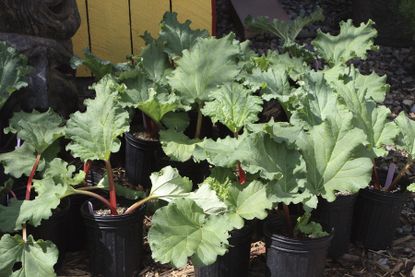Will Rhubarb Grow In Containers – Tips For Growing Rhubarb In Pots


If you have ever seen a rhubarb plant in someone’s garden, then you know that when conditions are optimal, the plant can become huge. So what if you love rhubarb and would like to grow it, but you have limited space? Will rhubarb grow in containers? Read on to learn more.
Will Rhubarb Grow in Containers?
Yes indeed, it is possible to grow rhubarb plants in containers. Almost any plant can be container grown; sometimes it just requires a pot large enough to accommodate it. In the case of rhubarb grown in containers, it’s not necessarily the width of the plant (although that is a consideration too), but the depth is of primary importance, as rhubarb has a large root system.
If you are going to try container grown rhubarb, use a sturdy container that is at least 20 inches (50.8 cm.) deep and wide. The larger the pot, the larger the plant can grow. When growing rhubarb in pots, the type of container isn’t important, but drainage holes are a must.
Growing Rhubarb in Pots
Grown for its red, pink or greenish-pink stalks, rhubarb (Rheum x cultorum) is a spectacular cool weather perennial hardy to USDA zones 3-8. A healthy plant can live and produce for a good ten years. Which means ten years of delicious desserts and preserves.
If you are interested in trying your hand at growing rhubarb plants in containers, be sure to use a lightweight, well-draining potting mix. It’s always beneficial to add in some compost as well. Plant divisions or purchased rhubarb crowns in early spring. Set the plant into a hole that is 1-3 inches (2.5-7.6 cm.) deep and back fill around the crown.
Set rhubarb grown in containers in full sunlight for best results, although rhubarb will tolerate some light shade. Water the crown until it is wet but not sodden.
Care of Container Grown Rhubarb
Rhubarb is really an easy plant to care for, whether grown in a container or in the garden plot. Keep in mind that any plant grown in a pot will dry out more quickly than those in the garden, especially during heat spells. Water this plant down near the soil to keep the leaves dry.
Gardening tips, videos, info and more delivered right to your inbox!
Sign up for the Gardening Know How newsletter today and receive a free download of our most popular eBook "How to Grow Delicious Tomatoes."
You can also add 1-2 inches (2.5-5 cm.) of mulch, like grass clippings or bark chips, on top of the soil to help retain water. Garden grown rhubarb is quite self-reliant and generally doesn’t need any fertilization. Container grown rhubarb, however, can benefit from a feeding every year prior to any signs of new growth in the spring. Use ½ cup (120 mL.) of 10-10-10 fertilizer around the base of the plant and water well.
Be patient and let the rhubarb mature into its second year before harvesting. Remove any flowers that blossom in the spring to allow all the plant’s energy to go into producing stalks. Cut the old stalks back in the fall once the leaves die back.
Rhubarb needs to feel the chill, so while you want to protect the plant's roots before winter, don’t cover the buds or crown with mulch or compost. Divide your rhubarb every five or six years to engender robust stalk production.
Note: Keep in mind that while the stalks are safe to eat, rhubarb leaves are toxic. They contain oxalic acid, which can be especially harmful to children and pets.

Amy Grant has been gardening for 30 years and writing for 15. A professional chef and caterer, Amy's area of expertise is culinary gardening.
-
 How To Grow Garden To Table: A Guide For Home Cooks
How To Grow Garden To Table: A Guide For Home CooksWhat could be better than a meal that comes directly from garden to table? Show off your gardening and culinary skills with the very freshest food.
By Bonnie L. Grant
-
 Want a Backyard Mini Orchard? Create Your Own Container Orchard
Want a Backyard Mini Orchard? Create Your Own Container OrchardEasier to care for in small spaces, a backyard mini-orchard makes sense for busy gardeners and juicy fruit is the reward.
By Teo Spengler